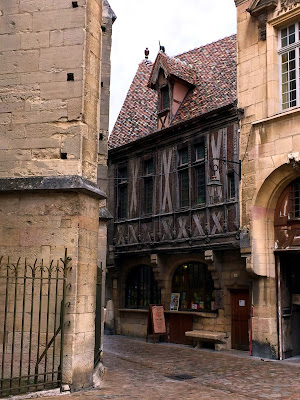We finally made it to Rouen May 24,2017. We took the train from Paris and arrived in Rouen in 45 minutes.The train station is just outside of the old city which is, primarily, a pedestrian area; cobblestoned with many timbered buildings.
Throughout history, Rouen has been an important city. Located on the Seine river, it is a seaport. It is also the capital of the Normandy region of France.
We opted to walk since it was downhill. I had the small hand drawn map from Rick Steeve's Guide. We followed it and first stopped at the Abbey of St. Ouen on the way to the Cathedral. We passed by the Ceramics Museum, Museum of Fine Arts and the Ironworks Museum, which was closed until the afternoon.
Abbey St. Ouen
The statue of Napolean stands in front of the Hotel de Ville (city hall); adjacent to the Abbaye St. Ouen.
Founded in 563, it was an important Benedictine monastery. The abbey was sacked, destroyed and rebuilt several times during France's violent history. No longer a place of worship, it was listed as a historic monument in the 19th century. Today it is used for concerts and exhibitions.
 |
| gargoyles |

The nave is very tall (108 ft.), higher than Rouen Cathedral and it is very bright inside due to the 3 tiers of windows. The monks wooden stalls have been maintained as well as the ironwork. The stained glass dates to the 14th century.
 |
| This stained glass was above the door leading out to the cloister. |
Outside the covered walkway is a remaining part of the original cloister.
The renowned organ is massive. It is housed in oak and is said to be the finest in France.
From the Abbey we walked a couple blocks to the Cathedral, passing many timbered buildings. Did I mention all the cobblestones?
 |
| That is the spire of Rouen Cathedral. |
 |
| This is the spire of St. Maclou which is behind the Cathedral |
I loved the variety of architecture. The alleys and streets were narrow and you could just imagine what it was like in Medieval times. Below is a narrow passage between two streets. There were small,pretty courtyards in there!
Rouen Cathedral
There is a large square in front of the Cathedral where you can find the Tourist Information booth, souvenir shops and some really nice cafes. The one we chose, Paul's, had the BEST croque madam. Woody had chicken with cider sauce. A very good lunch. There was also one of those little trains that take you around the area. It would have been perfect since I had Achilles tendonitis and walking was becoming difficult; but it was booked through the afternoon.
There was a lot of exterior restoration going on. The statues of the Apostles (and others) had been removed from the facade and were placed inside the Cathedral.
The nave is tall and the interior quite bright with all the tall stained glass windows. This is a side chapel.
We had seen a replica of this carved stone stairway at the Architecture Museum in Paris. Awesome!
The pillars were massive while appearing light and delicate. I am always reminded of Ken Follet's Pillars of the Earth when touring a gothic Cathedral.
I don't think I got the best photos of the stained glass.A tripod sure would help! I would love to see one of these incredible windows created and installed.
After the Cathedral, I wanted to see the Plague Cemetery. My feet were screaming and I didn't know how much more walking I was going to be to do. The plague cemetery was close by. It was built at the time of the Black Plague in1348. Three fourths of the St. Maclou parish died and the small church cemetery had no more room for the dead. So another cemetery was created next to the church and the victims of the plague were buried in communal graves. Later 4 galleries were built around the cemetery to create a central courtyard. Three of these galleries were used as an ossuary during a later plague. The 4th gallery served as a school.
The eerie decorations on the gallery buildings included skulls, cross bones and grave diggers tools. From the 18th century, burials were forbidden in town centers.
After the cemetery we began heading towards the train station. We stopped at the Ironworks Museum that had been closed in the morning. It was small, interesting and free. The museum was housed in an abandoned church.
 |
| Notice on the wall what appears to be the original "Swiss army knife". |
 |
| There were several display cases of keys. Some were extraordinarily large. |























































